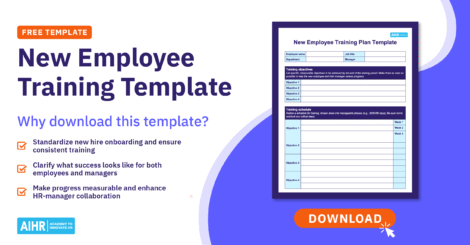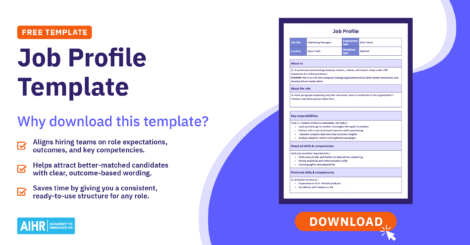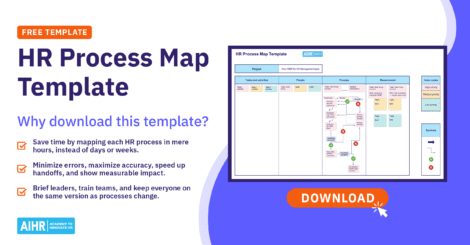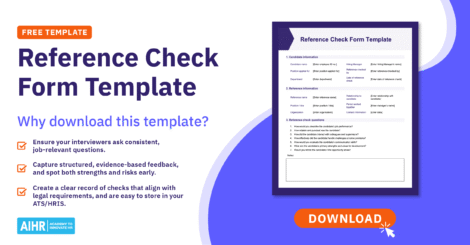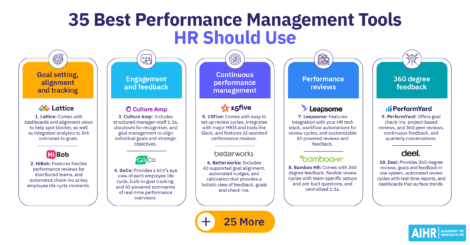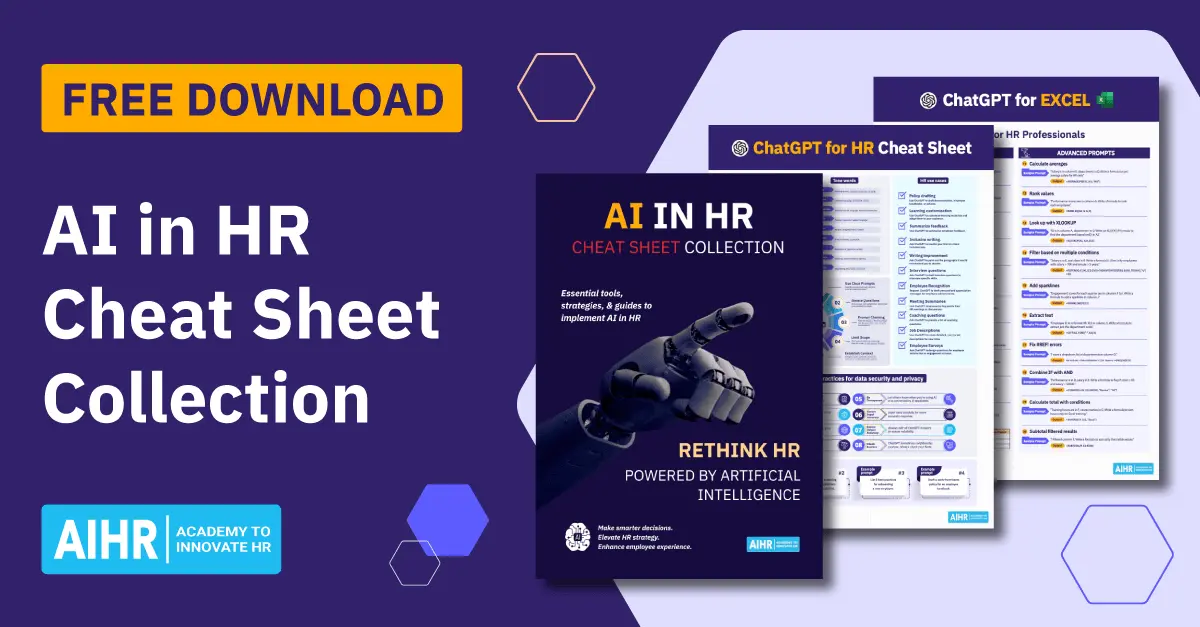According to an HR Research Institute report, 85% of organizations have a performance review process that is either fully structured or combines formal and informal elements. A performance review template provides a clear framework for your process, helping employees understand how they’re progressing in their roles, what actions can support their career growth, and how their work contributes to the organization’s success.
In this article, we’ll cover what an employee performance review is, the benefits of using templates, the different types available, and how to create and tailor one to fit your organization’s appraisal process.

Contents
What is a performance review?
Benefits of using a performance review template
Essential components of a performance review template
Types of performance review templates
Employee performance review follow-up
How to use a performance review template effectively
FAQ
What is a performance review?
A performance review is a formal process used to evaluate an employee’s past performance, clarify expectations, and set future goals that align both individual aspirations and organizational needs. It’s a central part of performance management and typically takes place annually, biannually, or quarterly.
Performance reviews serve several key purposes:
- Holding employees accountable by assessing their performance against organizational objectives.
- Motivating employees by acknowledging their achievements and strengths.
- Identifying areas for improvement and opportunities for growth.
- Offering constructive feedback to enhance productivity and develop new skills.
- Discussing compensation, professional development, and career progression.
In most cases, an employee’s direct supervisor or manager conducts the review, since they’re most familiar with the employee’s responsibilities and day-to-day work. However, HR plays a vital role in guiding and supporting the overall performance management process. This includes:
- Providing standardized guidelines and templates.
- Training managers to deliver clear, constructive feedback.
- Reviewing and analyzing performance review data.
Gallup’s research shows that meaningful, ongoing feedback boosts engagement and performance. When feedback happens regularly rather than once a year, employees stay more motivated and aligned with organizational goals.
Other types of performance management processes
- Performance appraisal: A formal, structured evaluation of an employee’s job performance and productivity, typically focused on specific tasks, goals, and achievements within a set period.
- Employee evaluation: A broader assessment that looks at an employee’s overall performance, skills, and professional development, often emphasizing long-term growth and potential.
Although many organizations are shifting toward continuous feedback, formal performance reviews are still a key part of performance management. They provide a structured snapshot of an employee’s progress, highlight strengths and development areas, and create a basis for setting future goals.
A performance review template helps standardize this process, making it easier for both managers and employees to align on expectations, discuss outcomes, and plan next steps for development.
Benefits of using a performance review template
Rather than using random formats across the organization, basing employee reviews on a sample performance review template renders higher-quality evaluations.
Here are the key advantages an employee performance review template has to offer:
- Consistency: A template creates a structured, objective framework for assessing performance. It helps ensure that every employee is evaluated using the same criteria, reducing bias and making comparisons across teams or departments more equitable.
- Higher-quality feedback: A well-designed template guides managers through each stage of the review, prompting them to give specific, actionable feedback in defined categories. Employees receive detailed input linked to measurable behaviors or outcomes, helping them understand their strengths, areas for improvement, and next steps for growth.
- Clear expectations: Templates provide categories and rating scales that give employees a clear picture of how their performance will be measured. This fosters accountability, so employees don’t have to speculate on their priorities. They understand what it takes to succeed and know exactly where they should focus their efforts.
- Better documentation: A written record of each review captures progress and performance patterns over time. This documentation supports promotion, compensation, and development decisions and helps protect the organization in the event of disputes.
- Efficiency: Having a predefined format saves time for both managers and HR. Managers can focus on meaningful feedback instead of designing their own process, while HR teams benefit from a more consistent and manageable review cycle across the organization.
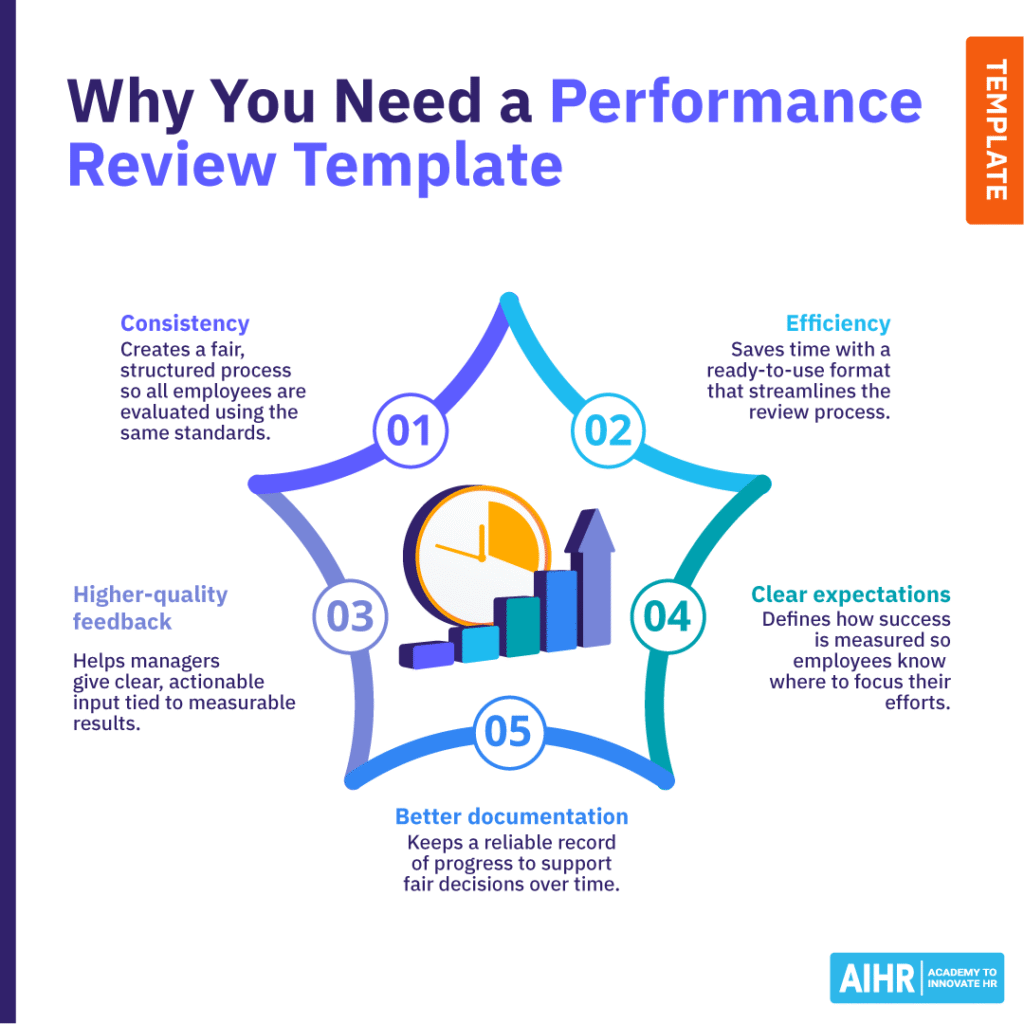
HR tip
A well-structured review process doesn’t just evaluate performance, it helps employees see a clear path for growth. Use templates to make goal setting and feedback conversations more transparent and effective.
Essential components of a performance review template
Performance review templates can look different from one organization to another, depending on company size, culture, and priorities. The components below are general guidelines that apply to most review formats, but they may vary based on the type of performance review; for example, whether it’s an annual, 360-degree, or self-performance.
- Employee and reviewer information: Start with basic details such as the employee’s name, position, and department, along with the review period, date of the previous review, and the reviewer’s name and title.
- Performance evaluation: This section is the core of the review and typically includes:
- Criteria: The main performance areas or competencies tied to the role, such as technical skills, quality of work, communication, problem-solving, attendance, and teamwork.
- Rating scale: A scoring system used to evaluate each criterion.
- Comments: Space to elaborate on the ratings with specific, detailed feedback.
- Strengths and areas for improvement: Dedicated sections to highlight accomplishments and identify where development is needed.
- Goal setting: A section for outlining future goals agreed upon by both the manager and the employee. Using the SMART framework (Specific, Measurable, Achievable, Relevant, Time-bound) helps make these goals actionable and measurable.
- Training and development: An area to propose training programs, upskilling opportunities, or career development steps that align with the employee’s goals and organizational needs.
- Self-assessment: A section where employees reflect on their own performance, share their achievements, and offer input on their progress.
- Overall performance: A final summary rating that combines the evaluation results, with space for additional comments or context.
- Signatures and acknowledgment: A confirmation section for both the reviewer and the employee to sign, acknowledging that the discussion took place and that the review accurately represents the conversation.
Transform performance reviews into strategic talent conversations
If you’re using performance reviews to simply rate employee output, you’re missing a valuable opportunity to develop, retain, and grow your top talent. The Talent Management & Succession Planning Certificate Program by AIHR goes beyond templates—it teaches you how to design and implement a full-scale talent strategy.
✅ Learn to build a strategic performance framework
✅ Master talent mapping, reviews, and leadership development
✅ Proactively plan for future talent needs with workforce & succession planning
✅ Create a unified talent experience that fosters retention and engagement
🎯 Turn reviews into roadmaps for growth.
Types of performance review templates
There are various types of templates to choose from as a framework for performance reviews. Here’s an overview of nine commonly used employee performance review templates:
1. Annual performance review template
This template evaluates an employee’s performance over the course of a full year. It usually summarizes competencies, key achievements, goal progress, and future objectives.
Advantages:
- Provides a structured, big-picture view of performance trends and overall progress
- Encourages in-depth discussions between managers and employees
- Serves as a foundation for compensation-related decisions such as raises, promotions, and bonuses
- Helps identify broader development needs and career growth opportunities.
Drawbacks:
- Reviewing performance only once a year can cause mid-year issues to be overlooked
- Compiling a year’s worth of data is time-consuming without ongoing check-ins or regular documentation.
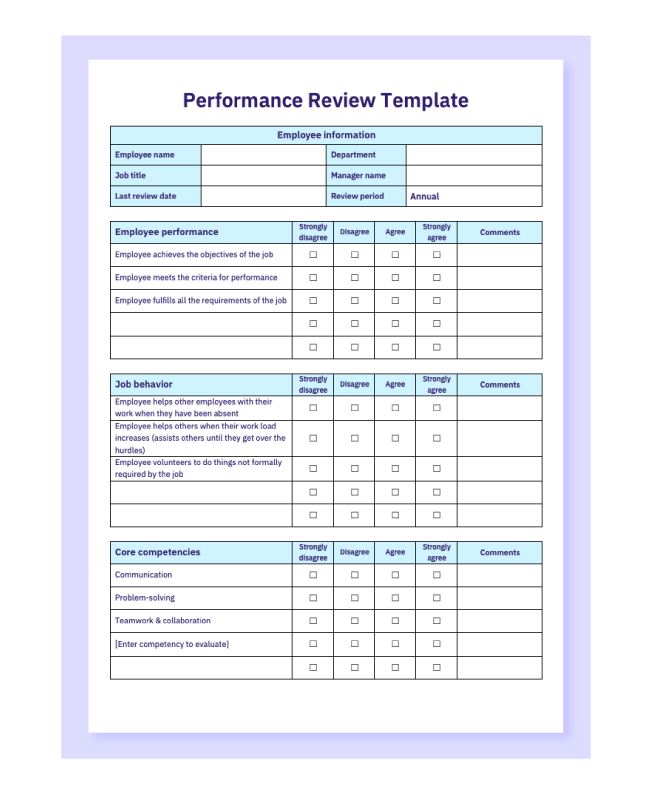
2. Quarterly performance review template
A quarterly review focuses on performance over a three-month period. It highlights recent achievements, progress toward goals, challenges, and priorities for the upcoming quarter. You can use the same template as the annual review, simply adjusting the review period and narrowing the focus to short-term goals and outcomes.
Advantages:
- Provides formal feedback four times a year, promoting continuous improvement and course correction
- Enables more agile goal adjustments to align with shifting priorities
- Keeps reviews shorter and more focused.
Drawbacks:
- The short-term focus can overshadow longer-term development goals
- Frequent reviews may lead to repetitive discussions on similar issues.
3. 360 performance review template
A 360 review gathers feedback from multiple sources, managers, peers, direct reports, and sometimes customers, alongside a self-evaluation. It provides a comprehensive view of an employee’s strengths, weaknesses, and development opportunities, typically by combining rating scales with open-ended questions.
Advantages:
- Provides well-rounded feedback that reduces manager-only bias
- Delivers deeper insights to guide professional development and career planning
- Encourages accountability to a broader group beyond the immediate supervisor
- Particularly valuable for leadership and management roles.
Drawbacks:
- Collecting and consolidating feedback from multiple sources is time-intensive
- Personal biases or relationships may influence the quality or honesty of responses.

4. Employee review template
An employee review template creates a written record of a dialogue between a manager and an employee. The conversation focuses on evaluating performance, accomplishments, strengths, and areas for improvement to support employee development. The template facilitates a discussion that promotes two-way communication on achievements, challenges, and next steps.
Advantages:
- Encourages open, meaningful dialogue that helps employees feel heard and supported
- Creates a written record for tracking progress and follow-up.
Drawbacks:
- Overreliance on the template can make the discussion feel rigid or scripted
- Strictly following the form may limit spontaneous, authentic exchanges.
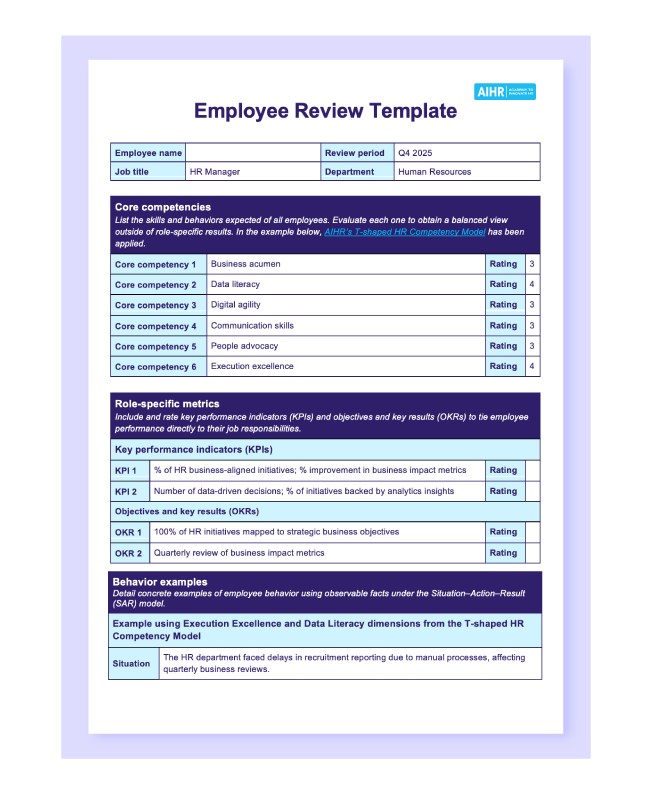
5. Employee evaluation template
This traditional employee evaluation template is used for annual, semi-annual, or quarterly employee performance assessments. It measures the employee’s past output against their job criteria and is used in conjunction with salary adjustments, promotions, or disciplinary actions.
Advantages:
- A uniform and transparent framework
- Walks managers and employees through the process of appraising performance, considering development needs, and setting goals.
Drawbacks:
- If the template’s scope is too rigid or narrow, important accomplishments, skills, or traits may go unheeded
- Focusing primarily on past performance doesn’t account for real-time development that should be acknowledged and encouraged.
6. Competency-based performance review template
This type of review focuses on assessing employees based on the core and job-specific competencies essential to success in their roles and within the organization. The template typically includes sections for both universal company competencies and technical skills that are critical for each position. It also provides space to note areas for improvement and set new objectives for the next review period.
Advantages:
- Helps employees understand how their performance connects to organizational goals
- Emphasizes behaviors and skills rather than just end results
- Encourages meaningful conversations about development and capability building.
Drawbacks:
- Developing a comprehensive competency model requires significant time and collaboration between HR and leadership
- Soft-skill competencies are often harder to define and measure accurately
- Overemphasizing idealized behaviors can sometimes limit authentic performance within specific roles.
7. Simple performance review template
As the name suggests, this template keeps things straightforward. It typically includes a short list of performance qualities and skills, a rating scale (for example, from “unsatisfactory” to “excellent”), and sections for reviewing progress on past goals and setting new ones.
Advantages:
- Easy to use and requires minimal training for managers
- Keeps feedback focused on key performance elements, making reviews concise and practical
- Simplicity increases the likelihood that managers will conduct reviews more frequently, such as monthly or quarterly.
Drawbacks:
- Lacks the depth and nuance of more detailed templates, which may cause important areas to be overlooked
- The simplicity can lead to more subjective evaluations if managers rely too heavily on personal impressions.
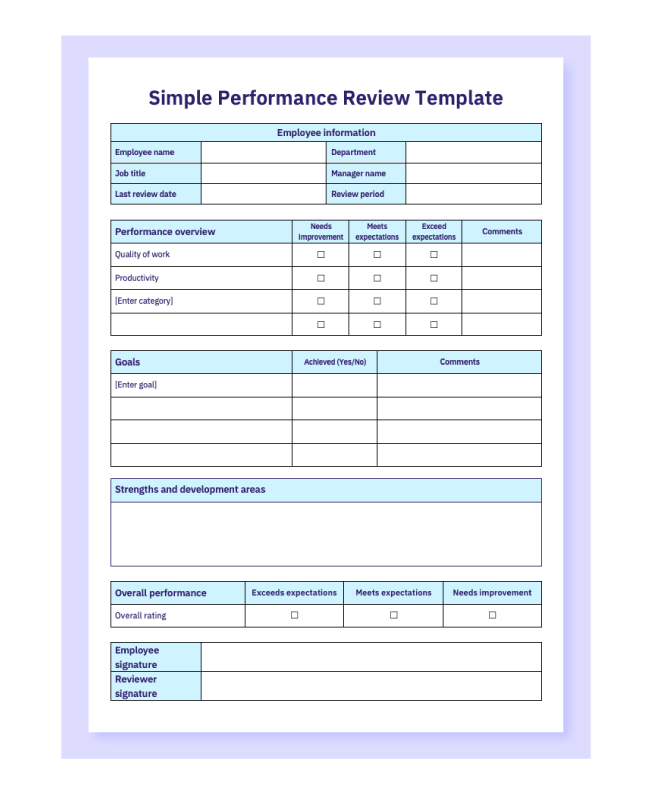
8. Manager performance review template
This template assesses the effectiveness and impact of managers, highlighting both their strengths and areas for development. It focuses on leadership skills, team outcomes, and how well managers support organizational goals. Many versions include sections for self-assessment and feedback from senior leaders.
Advantages:
- Promotes consistency by using standardized criteria across departments
- Holds managers accountable for leadership capabilities such as communication, decision-making, and coaching
- Identifies leadership gaps to inform targeted development initiatives
- Reinforces alignment between managerial performance and organizational priorities.
Drawbacks:
- May require different versions for various leadership levels, as expectations differ between team leads and executives
- Evaluators might need guidance to navigate personal relationships and rate managers objectively.
9. Self-performance review template
This format allows employees to evaluate their own performance in preparation for a formal review. It encourages reflection on achievements, challenges, and development needs, helping employees identify what support or resources they may need to succeed.
Advantages:
- Sets the stage for open, productive discussions during performance reviews
- Gives employees a stronger voice in the evaluation process
- Fosters a sense of accountability and ownership over personal development and career growth.
Drawbacks:
- Some employees may find self-evaluation difficult and either overestimate or underestimate their performance
- Without good communication, discrepancies between self-assessments and manager evaluations can lead to tension or misunderstandings.
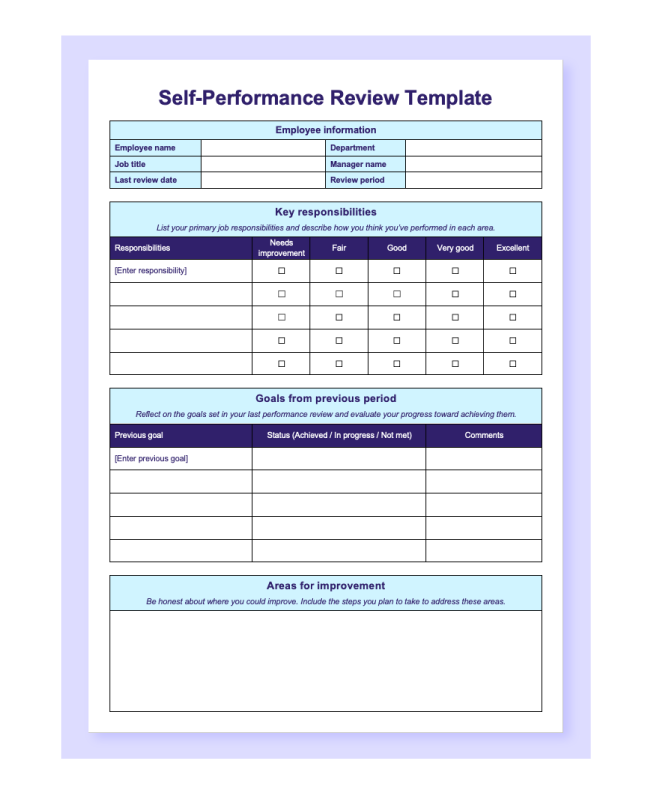
Employee performance review follow-up
Performance review sessions on their own may not be enough to persuade employees to apply the feedback they’ve received. When a manager follows up with another step, it reinforces employee action and accountability and shows the employee that their professional growth is valued.
Let’s take a look at three documents HR can implement to aid managers in post-review employee coaching:
10. Employee development plan
An employee development plan helps employees acquire the skills and knowledge necessary to excel in their current roles and prepare for future opportunities within the organization. It aligns the employee’s career goals with the company’s strategic objectives.
The plan typically includes both short-term and long-term goals, along with the actions required to achieve them, such as completing training programs, taking on stretch assignments, or earning certifications. This provides employees with a clear path for growth, supported by consistent guidance from their managers.
Documenting a development plan ensures that employee ambitions are aligned with business priorities. It also demonstrates that the company values its people and is committed to helping them grow.
11. Performance improvement plan
A performance improvement plan (PIP) is a collaborative effort among the manager, employee, and HR to address performance issues that prevent the employee from meeting expectations. A PIP is designed to be developmental rather than disciplinary. It provides structure, direction, and resources to help employees overcome obstacles and improve their performance.
Each plan should include:
- A description of the performance issues and specific areas that need improvement
- Evidence or examples of where performance has fallen short
- Clear and measurable goals for improvement
- Actions the employee must take to meet expectations
- A defined timeline for achieving results
- The resources and support the company will provide
- Consequences or next steps if goals are not met.
Although each plan should be tailored to the individual situation, using a standard performance improvement plan template helps maintain consistency and fairness across the organization.
12. Career progression framework template
A career progression framework template outlines to employees what advancement opportunities look like within the organization. It promotes transparency and helps them understand the skills, experience, and results required to advance.
A career progression framework template typically includes:
- Job titles and levels
- Job profiles that define responsibilities, performance standards, and key skills
- Technical, practical, and leadership competencies for each role
- Criteria for evaluating readiness for advancement
- Development opportunities and examples of potential career paths.
After a performance review, managers can use this framework to demonstrate to employees how their feedback and development goals relate to specific career opportunities. This helps employees link their current performance improvements to their long-term professional growth.

How to use a performance review template effectively
There is much more to a performance review template rollout than just selecting a format. It must also be crafted and executed effectively to impact employee and organizational success.
Keep the following best practices in mind:
- Customize the template to fit your organization: A standardized structure provides a strong foundation, but it can feel too generic on its own. Adapt the wording, rating system, competencies, and criteria to match your organization’s values, culture, and language. Employees should recognize the tone and terminology from your other HR materials and internal communications.
- Align the template with business and team goals: Ensure the template aligns with broader company objectives, allowing employees to see how their work contributes to strategic priorities. Link performance criteria and competencies to organizational goals such as market expansion, customer satisfaction, or profitability. This helps employees understand the impact of their efforts on overall success.
- Train managers: Templates are only as effective as the people using them. Train managers on how to fill out the form, translate their notes into constructive feedback, and remain objective during evaluations. Newer managers may benefit from role-playing exercises to practice giving balanced, confident feedback and addressing performance gaps effectively.
- Use the template as a guide, not a script: Encourage managers to treat the template as a flexible framework rather than a rigid checklist. They can tailor the discussion to the employee’s situation, spending more time on relevant topics and skipping less applicable sections. This personalized approach helps employees feel that the review is meaningful and focused on their specific needs.
- Balance ratings with written feedback: While numerical ratings provide structure, written comments add context and depth. Thoughtful feedback helps employees understand not just how they performed, but why they received a particular rating and what they can do next.
- Get input on how the template is working: Gather feedback from both managers and employees about the template’s clarity, usefulness, and overall experience. Ask which sections feel most valuable and whether any parts are confusing or repetitive. Small adjustments can go a long way toward improving the quality of performance conversations.
Over to you
A well-designed performance review template is one of the most valuable tools for managing and developing employee performance. It enables managers to deliver focused and consistent feedback, while helping employees set clear goals that align with the company’s direction.
Use our free performance review templates and best practices to create a process that keeps your teams engaged, motivated, and committed to achieving success—both for themselves and for the organization.
FAQ
A performance review template brings structure, transparency, and fairness to the review process. It provides a consistent framework so that all employees are evaluated using the same criteria, which helps minimize bias and promote objective assessments. It also supports meaningful feedback conversations, which research shows can boost performance and reduce turnover.
A performance review template should include key details such as employee and reviewer information, a list of performance competencies with a rating scale, and sections for comments, strengths, and areas for improvement. It should also have space for goal-setting notes and signatures from both the reviewer and employee to confirm the discussion took place.
Writing a performance review document starts with designing a clear, standardized template that ensures fairness and consistency across the organization. The template should guide managers to evaluate performance against defined objectives, provide specific examples of achievements and challenges, and deliver constructive, actionable feedback. The goal is to create comprehensive, balanced, and focused reviews that prioritize employee growth.
A strong performance review highlights accomplishments, provides balanced feedback, and supports professional development. It utilizes a structured rating system, incorporating sections to acknowledge achievements, address areas for improvement, and establish measurable goals. The best reviews combine data-driven evaluations with thoughtful, personalized feedback that helps employees understand both their impact and their opportunities for growth.










